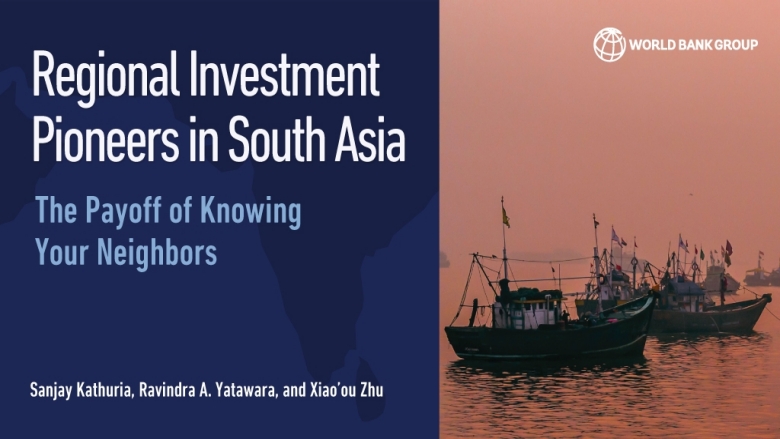Regional Investment Pioneers in South Asia- The Payoff of Knowing Your Neighbors
South Asia’s low levels of intraregional economic engagement hurt its consumers, workers, firms, and region’s overall economic growth. Intraregional trade is only 5-6 % of the total trade, and less than a third of its potential. Intraregional investments are even lower at barely 0.6 % of the total inward FDI from the world, and 2.7 % of the total outward FDI to the world.
The World Bank’s new report, Regional Investment Pioneers in South Asia - The Payoff of Knowing Your Neighbors, explores the potential of intraregional investments and some understudied constraints to such investments. The report also emphasizes the role of knowledge connectivity— that is how well the firms know the economic and investment environment in another country—in boosting cross-border engagements.
Post COVID-19, regional economic engagements will be critical to recovery and growth due to several factors including rise in trade and connectivity costs; push to diversify global value chains and shift them closer home; importance of services in global recovery and the growing services sector in South Asia; expanding regional consumer market; and the potential of regional trade to provide the buoyancy absent or muted in the global economy.
Constraints to Intraregional Investments
- Most OFDI policies in South Asia are restrictive, non- transparent, and discretionary.
- IFDI regimes are more liberalizing, but they have their own challenges by global standards, like arduous dispute resolving mechanisms, restrictions on land ownerships, and sector-specific restrictions.
- South Asian firms have low and polarized knowledge about the economic and investment environment in neighboring countries. This increases information friction and costs of searching for trustworthy partners. For FDI in services, knowledge-embedded networks are even more important for investment decisions.
- Bilateral mistrust increases transactional and contracting costs of economic engagement.
Pioneer Investors in South Asia
Despite constraints, regional pioneer investors in South Asia have built successful intraregional ventures across various sectors.
These investor firms tend to be:
- Prior exporters, who become regional investors as they gain more knowledge of the investment landscape
- Well-networked firms, with strong social and ethnic links
- Neighbors, especially for services investments
- Followers of pioneer investors in their conglomerate and business group
- Firms with high productivity and surplus investment funds
- Firms that use the region as a springboard to launch into global markets
Policy Recommendations
To tap the potential of intraregional investments, the report recommends four policy actions that do not entail large fiscal outlays:
- Relax OFDI regimes, even for smaller economies. This will enhance the competitive investment landscape and the ability of economies to respond to crisis situations like COVID-19.
- Promote smart IFDI promotion techniques and investment facilitation. These policies can target high-quality and high-visibility global firms, while smaller countries can target their affiliates that have already incurred the high entry costs.
- Support cross-border information-enhancing and network-development activities. These include industry-specific information web portals, intraregional networking events like industry meetings, investment missions abroad, cross-border women’s networks, and support to regional business associations.
- Accelerate digital connectivity and digitization to reduce trade costs. This includes building on initiatives like electronic trade documentation, automation of border management processes, and expanding electronic national single windows to regional trading partners.
